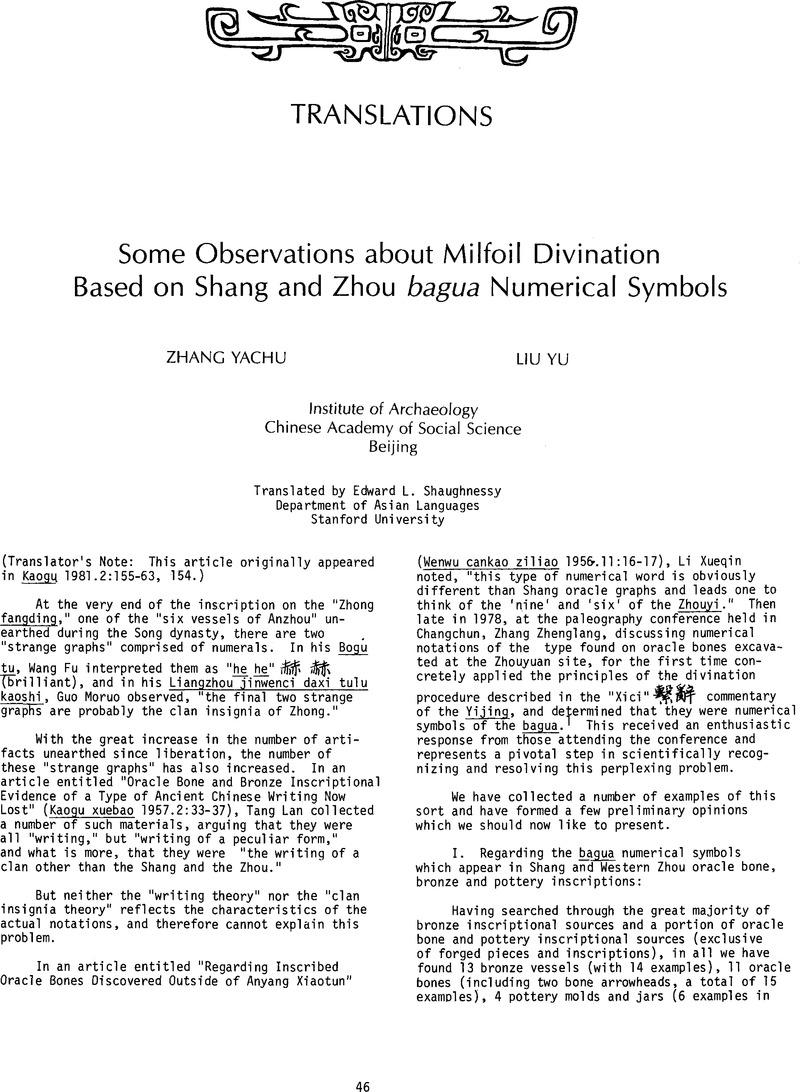Article contents
Some Observations about Milfoil Divination Based on Shang and Zhou bagua Numerical Symbols
Published online by Cambridge University Press: 26 March 2015
Abstract

- Type
- Translations
- Information
- Copyright
- Copyright © Society for the Study of Early China 1981
References
FOOTNOTES
1. Zhang Zhenglang's insight was subsequently published as “Shishi Zhouchu qingtongqi mingwen zhong de Yigua,” Kaogu xuebao 1980.4:403–415Google Scholar. For an English translation see Huber, H., Yates, R., et al., “An Interpretation of the Divinatory Inscriptions on Early Zhou Bronzes,” Early China VI (1980–1981):80–96 (Tr.)Google Scholar.
2. A passage in the Zuozhuan, 15th year of Duke Xi, reads: “The turtle [gives] the image and the milfoil the number.” This shows that in turtle-shell divination, what is auspicious and inauspicious appears in the images formed by the cracks in the shell, while divining by milfoil, what is auspicious and inauspicious appears in the numbers obtained from the milfoil-formed hexagrams. In an essay entitled “The Origin of the Bagua” (Kaogu 1976.4:242–45)Google Scholar, Wang Ningsheng has reported anthropological evidence of numerical divination.
3. Note such examples as the “Shaolao kuishi li” chapter of the Yili, (ch. 16) and in the Zuozhuan, 22nd year of Duke Zhuang.
4. Junyi, Fang, Zhuiyi zhai yiqi kaoshi (Shanghai, 1935):13:8Google Scholar.
5. “Xici zhuan” II.2Google Scholar; translated by Wilhelm, R. and Baynes, C., The I Ching or Book of Changes (Princeton, 1950):328–29Google Scholar.
6. Yantong, Zheng, Zhouyi tanyuan [In search of the origins of the Zhouyi] (Tokyo, 1976):19Google Scholar.
7. In a postscript to his 1980 article, Zhang Zhenglang notes that bagua numerical symbols were found incised on stone and bone implements at a neolithic site in Qingdun, Haian county, Jiangsu province; see Zhang:414, and Huber, Yates, et al.:93 (Tr.).
8. Shuda, Yang, Jiweiju Jinwen shuo (Beijing, 1952)Google Scholar. (I have been unable to locate this reference; Tr.)
9. For this reading of gai![]() as gai
as gai![]() , see Shiji zhengyi
, see Shiji zhengyi![]() (Sibu beiyao
(Sibu beiyao![]() ed.:4.5b; Tr.)
ed.:4.5b; Tr.)
10. Heng, Gao, Zhouyi gujing tongshuo [A comprehensive discussion of the ancient classic, Zhouyi] (Shanghai, 1947):3Google Scholar.
11. In the postscript to this 1980 article, Zhang Zhenglang has also reported evidence of the numbers 2, 3, 4, and 9 occurring in bagua numerical symbols. The authors of the present study are also aware of these recently discovered examples (private communication, 10 February, 1982).
12. “Xici zhuan” I.9Google Scholar, Wilhelm/Baynes tr.: 310-12.
13. Chapter I.9 of the “Xici zhuan” detailing the method of obtaining a hexagram (quoted above, p. 50) is not found in the Mawangdui manuscript (Tr.).
14. Each of the three tombs, M14, 56, and 103, in Gaocheng county, Hebei province, produced three oracle bones, all found on the second-level platforms, facing in the same direction, and apparently originally bound together with cord. This testifies to the general situation of divination making use of three oracle bones. See “Hebei Gaocheng Taixicun Shangdal yizhi fajue jianbao” [Excavation report of the Shang site in Taixi village, Gaocheng county, Hebei province], Wenwu 1979.6:40Google Scholar.
15. This thesis that turtle-shell divinations were performed in sets of three enjoys wide currency among oracle-bone specialists in China (see Yuxin, Wang![]() , Jianguo yilai jiaguwen yanjiu
, Jianguo yilai jiaguwen yanjiu ![]() (Beijing, 1981:96–99))Google Scholar, but there would seem to be some question as to the historical development of this practice. The sets of three turtle-shells described in note 14 date to Shang period V. But judging from sets of Period I shells discovered at Anyang by the Academia Sinica in the 1930s and published in Bingquan, Zhang
(Beijing, 1981:96–99))Google Scholar, but there would seem to be some question as to the historical development of this practice. The sets of three turtle-shells described in note 14 date to Shang period V. But judging from sets of Period I shells discovered at Anyang by the Academia Sinica in the 1930s and published in Bingquan, Zhang![]() , Yinxu wenzi, Bingbian
, Yinxu wenzi, Bingbian ![]()
![]() (Taipei, 1957)Google Scholar, there would seem to be equally good material evidence that turtle-shell divination, at least at the time of Wuding
(Taipei, 1957)Google Scholar, there would seem to be equally good material evidence that turtle-shell divination, at least at the time of Wuding ![]() , was performed in sets of five (Tr.).
, was performed in sets of five (Tr.).
16. Muruo, Guo, “Guanyu Yijing de xin” [A letter concerning the Yijing], Zhongguo shi yanjiu 1979.1:5–7Google Scholar.
17. Similar to this there is also a pair of halberds unearthed in Anyang, the inscription on which reads ![]() (see Yanku jijin tulu [Yanku catalogue of bronzes]:Xia.32. Although there are slight differences, this is close in form to the above-described five examples and possible belongs to the same type. If this is indeed so, it demonstrates that the upper limit of this kind of hexagram picture could be as early as the Shang dynasty, and the Taixuan system would then also have to be regarded as very ancient.
(see Yanku jijin tulu [Yanku catalogue of bronzes]:Xia.32. Although there are slight differences, this is close in form to the above-described five examples and possible belongs to the same type. If this is indeed so, it demonstrates that the upper limit of this kind of hexagram picture could be as early as the Shang dynasty, and the Taixuan system would then also have to be regarded as very ancient.
- 4
- Cited by


